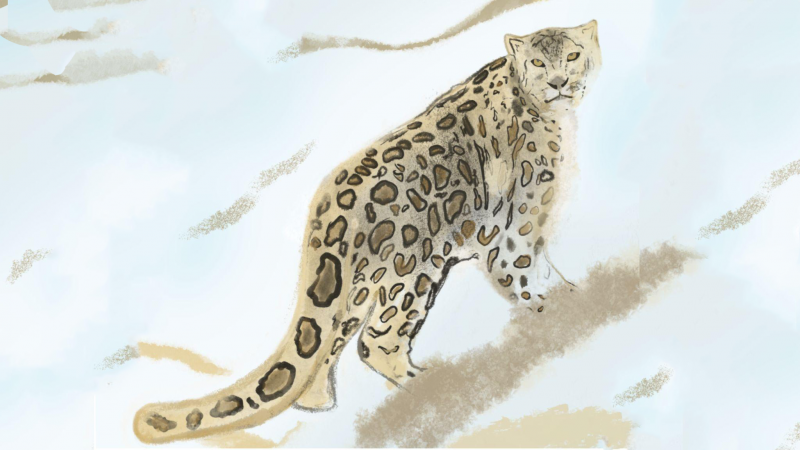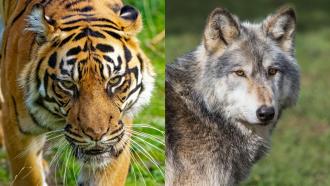
[Image Credits: Rupsy Khurana]
India accounts for 17% of the world’s human population residing in 2% of the global landmass. Large carnivores such as tigers and leopards exist alongside the human population. These charismatic animals play protagonists in many folklores, attract tourists to remote corners, but also come into conflict with people. Carnivores, especially big cats, often compete with humans for space and food, which drives the animal movement in a landscape and the use of habitat –– the various physical and biological resources that are crucial for an animal for foraging, cover, mating, and consequently its survival.
Spiti Valley in Himachal Pradesh is one among many multi-use landscapes shared between carnivores and agro-pastoralist communities. In 2020, the Government of India identified Spiti as one of the priority landscapes, an area prioritised for snow leopard conservation due to its potential to support a healthy population of snow leopards. Like all mountainous ecosystems, the valley is witnessing unpredictable climate fluctuations, burgeoning tourism, development activities, and business ventures. All these factors contribute to the loss and degradation of habitat affecting herbivorous animals like Bharal and Ibex, and consequently the predator, the one at the top of the food chain, snow leopard.
In a recent study, researchers from Nature Conservation Foundation, Mysuru, investigated the factors influencing snow leopards’ density and habitat use in the Spiti Valley. The study was published in the journal Plos One.
The agro-pastoral community in Spiti depends upon livestock for their survival. Yak, horse, goat, and sheep are common livestock owned by local communities. Due to the decrease in the wild herbivore population primarily comprising Ibex and Blue sheep, snow leopards often predate livestock. Incidents such as these cause substantial monetary losses to locals that often lead to retaliatory killings making coexistence a precarious tightrope.
The study area consisted of 50 hamlets and villages with a human population varying from as low as seven to a maximum of 700 people. The authors carried out field surveys to estimate the abundance of different species of wild prey in the landscape. Door-to-door surveys led researchers to reach an estimate of livestock in the area.
To evaluate the density of snow leopards, the researchers scanned the study area for pugmarks, scat, and scent marks of the animal. They deployed camera traps at 30 sites with animal presence between October-2011 to January-2012. The authors checked for wild prey and livestock population, distance from human settlement, altitude and terrain as factors affecting snow leopard habitat use. They used ecological models to investigate these factors and how they influence the animal presence in an area. They also checked if these areas were utilised uniformly by the snow leopards.
The camera traps captured 16 snow leopard individuals in 25 out of 30 trap sites in 80 days. In the study area of about 5000 square kilometres, only a few patches had more than one individual in a 100 square kilometres area. In more than 50% of the study area, one individual occupied as much as 500 square kilometres. The researchers found that the species preferred to move along mountain ridges and cliffs in rugged terrains at altitudes more than 4000 metres. The results highlight that wild prey, not livestock numbers, drives the snow leopard density. Another study has shown that wild herbivores do not prefer areas with high livestock numbers, and snow leopards do not prefer occupying them.
The researchers suggest that pockets of high wild prey density can help maintain snow leopard populations in such multi-use landscapes. Thus, maintaining habitat patches with wild prey is crucial to aid snow leopard conservation. “Minimising competition with livestock and preventing poaching or illegal hunting of wild prey for sustenance and sport can facilitate wild herbivore populations,” says Dr Koustubh Sharma, an author of the study. He is a scientist at Nature Conservation Foundation (NCF), Mysore and Snow Leopard Trust, Seattle, USA.
Snow leopards kill hundreds of livestock annually, forming up to 50% of their diet in some areas. Agro-pastoralists depend on agriculture and livestock for their livelihood, and involving them as stakeholders in conservation strategies is critical. It will enable the proactive engagement of the locals in the conservation of the species and allow wildlife-friendly agricultural and pastoral practices.
“It is crucial to establish grazing-free permanent or seasonal set-asides in consultation with the local communities, where livestock do not graze entire plant biomass,” says Koustubh. Building economic development models that are of high value but do not exploit nature, such as sustainable tourism, wildlife-friendly cashmere, wool, dairy, or meat, can lead to sustainable coexistence between people and wildlife, he adds.
The agro-pastoral communities’ lethal retribution against snow leopards due to their predation on livestock is an economic and conservation concern. Though such killings have reduced due to community involvement in conservation efforts, there is still more to conserving snow leopards and their habitat.
Snow leopard habitat is distributed in 2 million square kilometres, covering parts of India, Afghanistan, Bhutan, China, Kazakhstan, Kyrgyzstan, Mongolia, Nepal, Pakistan, Russia, Tajikistan, and Uzbekistan. There are cultural, political, geographical, and ecological differences across the land they inhabit. Earmarking patches of land where human inhabitation and action is limited by law is the current approach towards biodiversity conservation. It can help sustain healthy wild herbivore populations and thus large carnivores, says Dr Byron Weckworth. Byron, the Snow Leopard Program Director and Conservation Genetics Director for Panthera, a global wild cat conservation organisation, was not involved in the study. However, the rights of the traditional agro-pastoralists on their grazing lands cannot be ignored either. Byron opines that creating room for the coexistence of wild and domestic herbivore populations is the way to approach a balance. Biodiversity conservation needs to be holistic, not monolithic.
This article has been run past the researchers, whose work is covered, to ensure accuracy.






